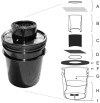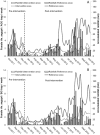Use of the CDC autocidal gravid ovitrap to control and prevent outbreaks of Aedes aegypti (Diptera: Culicidae)
- PMID: 24605464
- PMCID: PMC4631065
- DOI: 10.1603/me13096
Use of the CDC autocidal gravid ovitrap to control and prevent outbreaks of Aedes aegypti (Diptera: Culicidae)
Abstract
Populations ofAedes aegypti (L.) can be managed through reductions in adult mosquito survival, number of offspring produced, or both. Direct adult mortality can be caused by the use of space sprays or residual insecticides to mosquito resting sites, and with a variety of residual insecticide-impregnated surfaces that are being tested, such as curtains, covers for water-storage vessels, bednets, and ovitraps. The fertility ofAe. aegypti populations can be reduced by the use of autocidal oviposition cups that prevent the development of mosquitoes inside the trap by mechanical means or larvicides, as well as by releasing sterile, transgenic, and para-transgenic mosquitoes. Survival and fertility can be simultaneously reduced by capturing gravid female Ae. aegypti with sticky gravid traps. We tested the effectiveness of the novel Centers for Disease Control and Prevention autocidal gravid ovitrap (CDC-AGO trap) to control natural populations ofAe. aegypti under field conditions in two isolated urban areas (reference vs. intervention areas) in southern Puerto Rico for 1 yr. There were significant reductions in the captures of female Ae. aegypti (53-70%) in the intervention area The presence of three to four AGO control traps per home in 81% of the houses prevented outbreaks of Ae. aegypti, which would be expected after rains. Mosquito captures in BG-Sentinel and AGO traps were significantly and positively correlated, showing that AGO traps are useful and inexpensive mosquito surveillance devices. The use of AGO traps to manage Ae. aegypti populations is compatible with other control means such as source reduction, larviciding, adulticiding, sterile insect techniques, induced cytoplasmic incompatibility, and dominant lethal gene systems.
Figures







References
-
- Barrera R, Amador M, Diaz A, Smith J, Munoz-Jordán JL, Rosario Y. Unusual productivity of Aedes aegypti in septic tanks and its implications for dengue control. Med Vet Entomol. 2008;22:62–69. - PubMed
-
- Chadee DD, Ritchie SA. Efficacy of sticky and standard ovitraps for Aedes aegypti in Trinidad, West Indies. J Vector Ecol. 2010;35:395–400. - PubMed
-
- Chan KL. The eradication of Aedes aegypti at the Singapore Paya Lebar International Airport. In: Yow-Cheong C, Kai-Lok C, Beng-Chuan H, editors. Vector control in Southeast Asia. Sen Wall Press; Singapore: 1973. pp. 85–88.
-
- Chan KL, Ng SK, Tan KK. An autocidal ovitrap for the control and possible eradication of Aedes aegypti. Southeast Asian J Trop Med Public Health. 1977;8:56–61. - PubMed
MeSH terms
Grants and funding
LinkOut - more resources
Full Text Sources
Other Literature Sources

